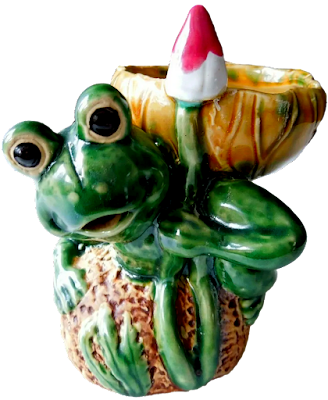The definition of “faux” is something that is fake.
One of the most popular areas of majolica collecting is that of frogs. I’ve written about genuine Victorian majolica frogs before in this blog but have never addressed the ENORMOUS number of modern majolica style creations that exist. The vast majority of these modern frog pieces are not copies of Victorian designs. They are contemporary creations done in a majolica style or “faux majolica.” Most of these are created by manufacturers, overwhelmingly from Asia, who try to capitalize on the popularity of Victorian frog majolica, often with an Asian aesthetic like the bowl below.
I have no problem with the manufacture of these pieces themselves. The problems arise when the paper labels that these pieces bear for import into the United States are removed for sale on the secondary market. These faux Victorian, or as they are usually advertised vintage pieces, are passed off by ignorant or disreputable dealers as being antique. The online auction site eBay is saturated with these vintage pieces as are auction houses. I get far more questions about these modern pieces than anything else, so I’ve decided to address some of these contemporary frog pieces in a special post.
The easiest way to detect these modern pieces that are being sold as antique is by the glaze. Victorian majolica is clear, transparent, shiny and iridescent. It is always a realistic representation of things in nature. Modern majolica is none of these things. It is generally cloudy or opaque and semi glossy. They often have unglazed areas incorporated into the design and designs are often cartoonish.
Modern pieces can be seen with two levels of craftsmanship: some well glazed; some sloppily made with glazes running into each other so badly you can’t tell one part of the design from the next. You would never see that in Victorian majolica. Even the most carelessly glazed Victorian pieces don’t have the kind of poor craftsmanship seen in modern pieces. The best way to illustrate my point is by showing some examples. I have included reproductions of Victorian designs here as well. They are identified as such.
One of the most commonly found pieces is actually based on an original Victorian design but modified rather drastically. I’ve written about these here. These faux Victorian majolica frog pitchers have become their own industry with a variety of different designs to choose from.
Looking at these examples you can see the cloudy nature of the green glaze that is used. Victorian glazes, like the one below, are never cloudy. They are always transparent.
Designs on these modern pieces are also often rather clumsy, like the vases below.
The posted images above are just a small fraction of the new frog pieces being currently made. For frog collectors who aren't looking for antiques they are very nice additions to a frog collection, but as antiques they are a complete fail.
I would give one word of advice on those who may be interested in purchasing these modern pieces. Almost all of them sell new at wholesale for under $10. They are imported from Asia by the thousands. I would suggest shopping around before buying for the best price. If you are an antiques collector however, pass them by.




































